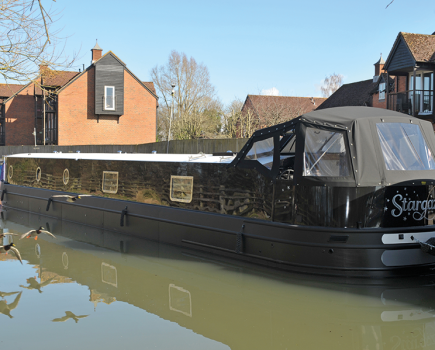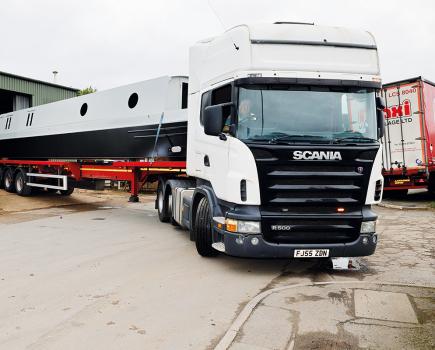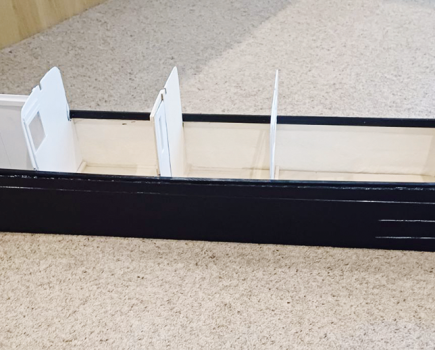With water levels all over the place on the canals and rivers in this year of weird weather, we look at some hints and tips for those thinking of taking to the rivers. Text and pictures by Martin Ludgate

When we started planning this article, the idea was to provide some hints and tips for boaters who might be tempted to forsake the drought-ridden canals and head for the somewhat better-supplied river navigations this year. By the time we came to write it up just a few weeks later, the spring rains had arrived with a vengeance and suddenly the rivers had too much water.

And that leads us very conveniently into the first of the three major differences to bear in mind when cruising on rivers rather than still-water canals, and which we will (at the risk of stating the blindingly obvious) spell out here:

• Water levels on rivers go up and down

• Rivers are natural channels which are likely to have more irregularities
• Rivers are much more likely to have appreciable currents
Our apologies if that sounds as if we think our readers are a bit dim – honestly we don’t – but it’s a handy way of grouping all the things that it’s useful to remember when boating on rivers. And as the first two are the easiest ones, we’ll deal with them first.
Levels
While the water level on a canal will tend to be close to the level of the overflow weirs (or sometimes on the low side – especially in the recent shortages), on rivers it can rise considerably after heavy rain. This has an obvious effect on the available headroom under bridges – and while many rivers have generous clearance by the standards of the narrow canals, that’s not always the case. For example the Wey, Stort, Lee and Nene all have some quite tight ones.
So while the guide books might well state the headroom to the nearest inch, bear in mind that levels can easily vary by a few inches. If you’re approaching a bridge with tight headroom, take it carefully – especially if you’re coming downstream and so can’t stop so quickly (see later under ‘currents’).
This probably sounds a bit obvious so far, but it’s not quite that simple. As the river level rises, due to the physical characteristics of a river, some lengths may be higher above normal water level than others. Different parts of the river will be affected more or less by excess water, depending on width, depth, size of weirs, whether you’re just above a weir or just below one, and so on.
So just because your boat fits under what’s normally the lowest bridge on the river, that doesn’t mean it will fit all of them.
The other time to remember changes in water level is when mooring. Don’t tie your ropes up too tightly, check and adjust them if the levels are changing, consider setting ‘spring lines’ (ropes leading forwards from the stern and backwards from the bow) and – like the old slogan about share prices – remember that rivers can go down as well as up. So if you feel or hear your boat scraping on the bottom when you come in to moor, beware that a fall in level might leave you high and dry or leaning over at an uncomfortable angle.
And on that subject, if levels are low, watch out for shallow water. This sometimes occurs where silt has been deposited (typically where weir streams join the navigation – try to give them a reasonably wide berth). It’s also often found on the inside of bends – a lot more so than on canals, and sometimes extends quite a
way out. Which brings us on to our second main point…
Irregularity
Note the words ‘typically’, ‘sometimes’ and ‘often’ in the last sentence. That isn’t just us hedging our bets; it’s a reflection of the fact that river navigations, being largely natural channels, aren’t as regular and predictable as canals. Now, I can already hear the hollow laughter at the word ‘regular’ from the aficionados of James Brindley’s school of canal engineering, but it’s true. You can’t count on the deep channel always being near the middle on the straight reaches or running around the outside of bends.
Another time to remember irregularities is when mooring up on a natural river section. Yes, it’s nice to tie up to a rough bank under some trees in the middle of nowhere, but do it gently in case the bed’s bumpy and rocky.
Also, don’t assume that the navigation arch of a bridge is the largest or central span – for example on the Warwickshire Avon the canal’s engineers and subsequent restorers didn’t always find that the most obvious arch was the easiest one to adapt for navigation. So look for indicator signs, and check your guidebook.
Lock approaches (again, the Avon is a good example) aren’t always easy to line up for, especially in a long vessel. Bends might go on further than you expect them to, or be followed immediately by a bend going the opposite way (I’m thinking particularly of the four tight bends in a row below Theale on the Kennet).
So, if you can’t see the way ahead clearly, think ahead, drop the engine speed and slow down first before you get to the tricky bit, then you can always put on a judicious burst of extra power if necessary to help you around.
And remember that in a deeper, wider, less constricted channel than most canals, you might well be going rather faster than normal for the same engine speed – and with the banks being further away, this might not be immediately obvious. So you might need to start slowing down earlier, especially as you’ll want to avoid using reverse if possible.
So why do you want to avoid using reverse? Because on a typical narrowboat, you’ll lose most of your steerage if you do. And while on a canal it’s embarrassing if your boat swings across the cut while you’re trying to slow down to moor up, on a river it can be more serious – which brings us to the third main issue…
Current
The most important difference between canals and rivers is that (with one or two exceptions such as the Llangollen) canals are pretty much still water, whereas rivers can have appreciable currents – especially after heavy rain.
Currents can be both a hindrance and an advantage – and what might not seem immediately obvious is that they can actually be more helpful when you’re going against them. Although it will slow you down a little, a head-on current will also make the steering more responsive. And conversely, when you’re going with the current it might help move you along, but it also makes manoeuvring more tricky.
For this reason, it’s a good idea (assuming there’s room to turn around) to always moor up pointing up-river. If you’re coming in to moor with the current behind you, trying to approach the berth slowly enough, then to apply enough reverse to stop the boat without it slewing round, can be quite awkward. Conversely, if you’re facing the current (especially if your engine’s tickover speed is quite low), you may well be able to slow the boat to a standstill with the engine still in forward gear, just matching the current. This means you can use the tiller to move the boat sideways (known as a ‘ferry glide’) into the berth.
When you come to set off again, you’ll enjoy the same manoeuvrability. And on the subject of setting off, always untie your downstream line first to stop the current spinning you around.
When you’re underway, you also need to bear the current in mind, especially if you’re heading downstream:
• You won’t be able to turn so tightly.
• You’ll need to keep enough speed on to maintain steerage, but not so much that you can’t slow down if necessary.
• The boat (and especially the stern) will get pushed towards the outside of bends.
So think ahead. Slow down well in advance, but try to avoid the need to go into neutral or reverse if you possibly can. If you have to use reverse to kill some speed, try to do
it in clear, open water, well in advance of having to manoeuvre.
Make your mind up which arch of a bridge you’re heading for in advance, and once you’ve decided, don’t change your mind. And if you do have to moor with the stream, have people ready with ropes – they might only get one chance.
And as for stopping in an emergency (for example if you have engine trouble) – that’s why you put your anchor out just in case.
When you’re heading upstream it’s easier but there are still things to remember:
• The boat (and especially the bows) will get pushed to the outside of bends.
• You will often have more control and be able to turn more tightly
• Boats coming towards you with the stream will be less manoeuvrable than you and be less able to stop (and some of them may be a lot bigger than a narrowboat!) – So take advantage of the greater control that you have to keep out of their way. And remember that it’s the downstream boat that should have the right of way at bridges.
River navigations normally combine canal sections with river sections, which gives you something to think about when going between the two – in particular when the lock cut joins the river at an angle. In these situations, when you’re entering the river from still water:
• Put enough power on to ensure that the current doesn’t take control of the boat
• Start by angling the bows slightly more towards the direction the current’s coming from than you would if you were joining another stillwater channel…
• …then once the bows are in the river, make sure you keep the stern clear of being pushed into the bank.
When you leave the river and return to still water at the next lock cut:
• Keep enough power on to ensure that the current doesn’t take control of the boat, but be ready to slow down if necessary as soon as you are in still water.
• Start by aiming slightly towards the upstream side of the lock cut…
• …then once the bows are in the lock cut, make sure you keep the stern clear of being pushed into the bank.
Still on the subject of currents, watch out for weirs and weir streams. Water flows entering the navigation will tend to push you away from them (possibly into the opposite bank if you aren’t careful) so angle the boat towards them; those leaving the navigation will pull you towards them, so angle the boat away.
In both cases, keep enough power on until you’re past them – and, as ever, think ahead so you don’t end up in the situation where you can’t do this without catching up with a boat in front or arriving at a lock before it’s ready.
Turning around on a river is another case where you need to think about the current. The current will tend to flow more quickly in the middle of the river, and towards the outside on bends – and sometimes this can actually help to turn the boat around. But do remember (especially if the river’s narrow enough that it will take several ‘goes’ to get around) that the current might mean that you end up some distance downstream by the time you’ve finished. Bear this in mind when choosing where to turn relative to moored boats or obstructions. Also, you will find that your boat has a natural tendency to turn one way or the other when in reverse – for a right-handed propeller, the bows will usually drift to the left – so you may be able to take advantage of this when deciding which way to turn around.
Finally, remember that all these are general hints and tips to give you an idea of what to allow for on rivers, especially when there’s more water in them than at normal summer levels.
You’ll get much more useful river-specific information from local boaters, or especially from lock-keepers on those rivers that still have them. Don’t be afraid to ask a lock-keeper’s advice – and if that advice is ‘tie up and wait for the current to decrease’, then be prepared to follow it.
Some rivers have warning systems to help you. These could be water level gauges, often in the form of a metal strip painted in three colours: if the water level is in the red section, you’re strongly advised to tie up somewhere safe; if it’s in the yellow, consider proceeding with caution; if it’s in the green, it’s fine.
On the Thames there is a system of red ‘strong stream’ warning boards and yellow ‘stream increasing’ or ‘stream decreasing’ boards with similar meanings. But make your own decision based on
your experience and judgement: if you’re struggling at all to make decent headway against the flow, or to control the boat at a safe speed with the current, find somewhere safe to stop.
And lastly, having perhaps worried a few of you with these warnings, some words of reassurance. Most of the time, almost all of our non-tidal navigable rivers have very little current and are perfectly safe even for the relatively inexperienced to navigate. They make a real change from canals, and (with just a little more thinking ahead) they’re a delight to cruise in perfect safety.
Image(s) provided by:
Martin Ludgate







